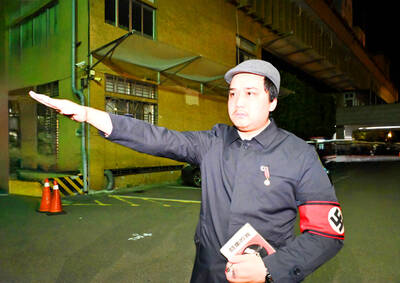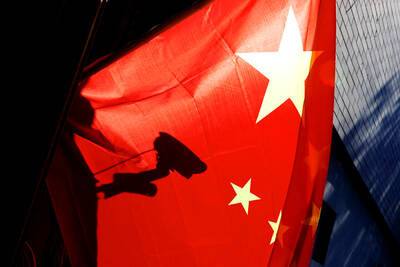The Chinese People’s Liberation Army (PLA) is capable of seizing Taiwanese islands, paralyzing the country’s defensive capabilities with cruise and short-range ballistic missiles, as well as by launching amphibious and airborne raids, to take Taiwan proper before forces from other nations could respond, the Ministry of National Defense said.
In the latest annual report on China’s military forces presented to the legislature, as stipulated in the National Defense Act (國防法), the ministry said that Beijing’s purpose in holding combined air-naval-ground exercises involving the PLA’s Second Artillery Force in recent years was to ensure that it would be able to launch a large-scale attack on Taiwan by next year.
According to the National Bureau of Asian Research, a Washington-based think tank, the Second Artillery Force is a strategic missile force of the PLA tasked with achieving strategic effects through direct engagement of key enemy targets.
China’s military modernization has improved the PLA’s capability to conduct “counterintervention operations” for “regional deterrence” missions to prevent foreign forces, like the US, from intervention in cross-strait conflicts, the report said.
The ministry said that the Second Artillery Force has continued to mass produce and install missiles despite the force already fielding an array of tactical ballistic missiles and cruise missiles that can reach Taiwan.
Meanwhile, the ministry said that the Dong-Feng 21D, medium-range anti-ship ballistic missile has the capability to deny an aircraft carrier from a third country from intervening in a conflict between Taiwan and China.
If a conflict broke out, China would expect to take Taiwan in the shortest time by conducting intensive air, missile and naval strikes, as well as a blockade of the nation with the objective being to cause panic in the country, and conducting an amphibious and airborne operation to land here, the ministry said.
China has previously characterized its military policy as purely “defensive” in nature, but it has shifted the policy to “diversification of armed forces use,” as stated in a Chinese defense white paper this year, the ministry added.
In reaction to the US-Japan island defense exercise in January last year, China held a spate of drills across the East and South China seas to highlight its claims to sovereignty over the region and to declare that the PLA’s primary missions go beyond Taiwan to include the seas, which are both among China’s “core national interests,” the ministry said.
The ministry said that China’s military presence in the South and East China seas — including its declaration of an air defense identification zone in the East China Sea last year — showed that Beijing’s desire to become a dominant power in Asia has endangered regional stability, with sporadic tensions with the US, Japan, South Korea and some Southeast Asian countries.
China’s defense spending has seen double-digit growth each year since 1989, and with a defense budget of US$132 billion this year, China is the biggest military spender in Asia and second only to the US in the world, the defense ministry said.
The ministry added that China views the years up until 2020 as a “strategic opportunity” to enhance its combat capabilities, while the military modernization it has undertaken over the years has turned its military into a force far beyond its need for self-defense.
Despite rapprochement in cross-strait relations, as the military imbalance between Taiwan and China grows and Taiwan remains the PLA’s primary mission, the military threats to the nation from China have not abated, the ministry said.

SECURITY: As China is ‘reshaping’ Hong Kong’s population, Taiwan must raise the eligibility threshold for applications from Hong Kongers, Chiu Chui-cheng said When Hong Kong and Macau citizens apply for residency in Taiwan, it would be under a new category that includes a “national security observation period,” Mainland Affairs Council (MAC) Minister Chiu Chui-cheng (邱垂正) said yesterday. President William Lai (賴清德) on March 13 announced 17 strategies to counter China’s aggression toward Taiwan, including incorporating national security considerations into the review process for residency applications from Hong Kong and Macau citizens. The situation in Hong Kong is constantly changing, Chiu said to media yesterday on the sidelines of the Taipei Technology Run hosted by the Taipei Neihu Technology Park Development Association. With

A US Marine Corps regiment equipped with Naval Strike Missiles (NSM) is set to participate in the upcoming Balikatan 25 exercise in the Luzon Strait, marking the system’s first-ever deployment in the Philippines. US and Philippine officials have separately confirmed that the Navy Marine Expeditionary Ship Interdiction System (NMESIS) — the mobile launch platform for the Naval Strike Missile — would take part in the joint exercise. The missiles are being deployed to “a strategic first island chain chokepoint” in the waters between Taiwan proper and the Philippines, US-based Naval News reported. “The Luzon Strait and Bashi Channel represent a critical access

‘FORM OF PROTEST’: The German Institute Taipei said it was ‘shocked’ to see Nazi symbolism used in connection with political aims as it condemned the incident Sung Chien-liang (宋建樑), who led efforts to recall Democratic Progressive Party (DPP) Legislator Lee Kun-cheng (李坤城), was released on bail of NT$80,000 yesterday amid an outcry over a Nazi armband he wore to questioning the night before. Sung arrived at the New Taipei City District Prosecutors’ Office for questioning in a recall petition forgery case on Tuesday night wearing a red armband bearing a swastika, carrying a copy of Adolf Hitler’s Mein Kampf and giving a Nazi salute. Sung left the building at 1:15am without the armband and apparently covering the book with a coat. This is a serious international scandal and Chinese

COUNTERINTELLIGENCE TRAINING: The ministry said 87.5 percent of the apprehended Chinese agents were reported by service members they tried to lure into becoming spies Taiwanese organized crime, illegal money lenders, temples and civic groups are complicit in Beijing’s infiltration of the armed forces, the Ministry of National Defense (MND) said in a report yesterday. Retired service members who had been turned to Beijing’s cause mainly relied on those channels to infiltrate the Taiwanese military, according to the report to be submitted to lawmakers ahead of tomorrow’s hearing on Chinese espionage in the military. Chinese intelligence typically used blackmail, Internet-based communications, bribery or debts to loan sharks to leverage active service personnel to do its bidding, it said. China’s main goals are to collect intelligence, and develop a